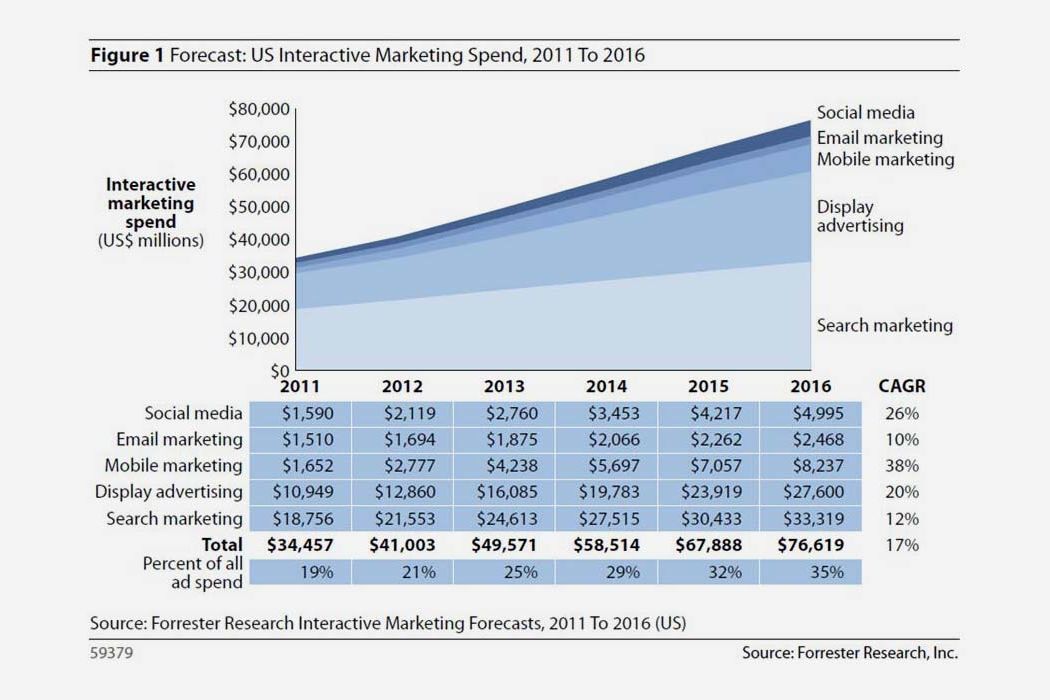With the average small business set to spend around $75,000 per year on digital marketing, it’s hard to know how to make those dollars stretch.
While that’s a good starting point, for businesses in competitive markets, that’s a single month’s payment to ONE consultant. When you’re trying to calculate a digital budget, you need to understand the basic budgeting formats that other marketing departments use.
Below are the 4 most common approaches to budgeting for a marketing campaign.

TLDR; Email, Social, Display Ads and SEO continue to grow in 2018. Digital marketing budgets are now $75,000 a year, or 35% of all marketing budget, on average, for businesses. Companies are shifting more and more money to digital because of it’s perceived R.O.I., ability to track performance and spend less for a greater return compared to conventional methods.
1. A Goal-Based Approach
Your first step in creating a better budget for your next marketing campaign is to look at what you spent in the past. If this isn’t your first rodeo, you should use the data from last year to get an understanding on what worked, what didn’t, and what you could improve.
There should be a correlation between promotions and sales. Otherwise, you’re going to be flying blind. If your previous sales figures didn’t see a bump from previous marketing efforts, this could also be seen as an opportunity for a new approach.
Talk to colleagues and other business owners nearby. See what you can learn from how they’re budgeting for their digital marketing campaigns. Even if you don’t have the same kind of audience, you can surely gain some insight into how to organize invoices, receipts, and income.
Be sure that in the future you’re watching for variances month to month so that you can learn whether your products are seasonal. This can help to create a calendar and a guide for the future.
Within your budget, you’ll need to have goals. Whether you have a single goal for a short sprint of a campaign or granular weekly goals for a longer promotion, you need to know where your milestones are. Without goals, it can be hard to measure the success of your campaign or how much you need to spend.
2. The Dartboard Method
This might sound silly, but depending on how established your brand is, it just might work. Get ahold of a dartboard, get yourself a dart, cover your eyes, and throw it. Whatever the number you land on is your new budget.
As crazy as this is, it can work for new companies who’ve never done marketing before. So long as you’re not spending hundreds of thousands on expensive consultants, you can learn by just establishing a random budget and collecting data. Remember, data beats assumptions. Every single time!

Obviously, you’ll need an upper limit before things start to get uncomfortable, but in general, you should be able to pick a reasonable number and proceed. Don’t let the budgeting process get in the way of learning what works for your company and what doesn’t.
If marketing results fall short, you’ll know to up the budget for next time. If you end up surprising yourself, you can build upon what worked. Either way, you’ll be learning a lot as you go along. Adventure is one of the reasons you started a business in the first place, right?
3. Percentage of Revenue
A lot of companies calculate their marketing budget based on the revenue that they earn. This might not make sense when you’re just beginning but after a year or two in business is totally standard.
For a small company, you could probably get away with spending up to 15% of your revenue in the search for new business. If you’re competing against bigger and more established companies, you might need to spend this much before you see any return at all.
Larger companies can get away with spending only about 5% of their revenue or less. Once you’ve established a strong brand, you can ride the momentum of that brand from one year to the next.
When you’re developing your budget, thinking about a percentage of your revenue is a nice round number, but since it can vary so much, it’s not always perfect. If a company is bringing in millions, 5% is a substantial amount of money to spend on advertising. However, if your business brought in just around $100,000 last year, $5,000 isn’t going to be enough to really grow any further.
Smaller companies need to stick their neck out a little further.
4. ROI Budgeting
You need to budget at some point based on how much of a return you can expect. You should start with an idea of how much you want to grow this year. If you want to make a million dollars and you’re currently hovering around 10% of that, you’ll have to put it all on the line for that kind of growth.
However, if you set your sights on growing by $100,000, you can probably expect a return of at least 3 to 1. That means you’ll have to start by investing $33,000 for your marketing to see $100,000 come in. Divided across the year, it’s a relatively small monthly budget that should be doable for more small businesses.
While you can’t expect a lot from marketing, especially if you’ve never done it before, with a little bit of practice, you’ll learn what your audience expects.
If you bristle at the idea of spending five figures on marketing, you’re probably not ready to grow yet. While some skittishness is understandable, you need to take risks to see the growth you want. Getting a return on investment is fairly reliable if you know your audience well enough.
Budgeting Formats Can Be Hybrids
There are no serious hard and fast rules about the boundaries of any of the aforementioned digital marketing budget calculations.
In fact, you can mix and match them as you please, creating your unique hybrid. The most critical element is that your digital marketing budget meets your company’s needs without too much extra fat.
If you want to get to know a few more tips about how to make your budget airtight, contact us for info.
If you enjoyed this article, please share it
About the Author:
Mike Carroll
Mike steers the overall strategy & direction at Bearhug Digital, promoting constant innovation and success.
Sometimes referred to as the ‘unicorn’, he has the ability to communicate and execute on big ideas effortlessly. Mike challenges his team to strive for excellence when crafting digital solutions. He leads from the front and is involved in every aspect of every project. With a passion for leveraging technology to solve business challenges, Mike’s eye for design and vision for scaleable solutions drives innovation and exponential results.
Related Posts
September 11, 2018
5 Reasons Your Website Should be Maintained by a Professional
Even a brand new website needs regular…




